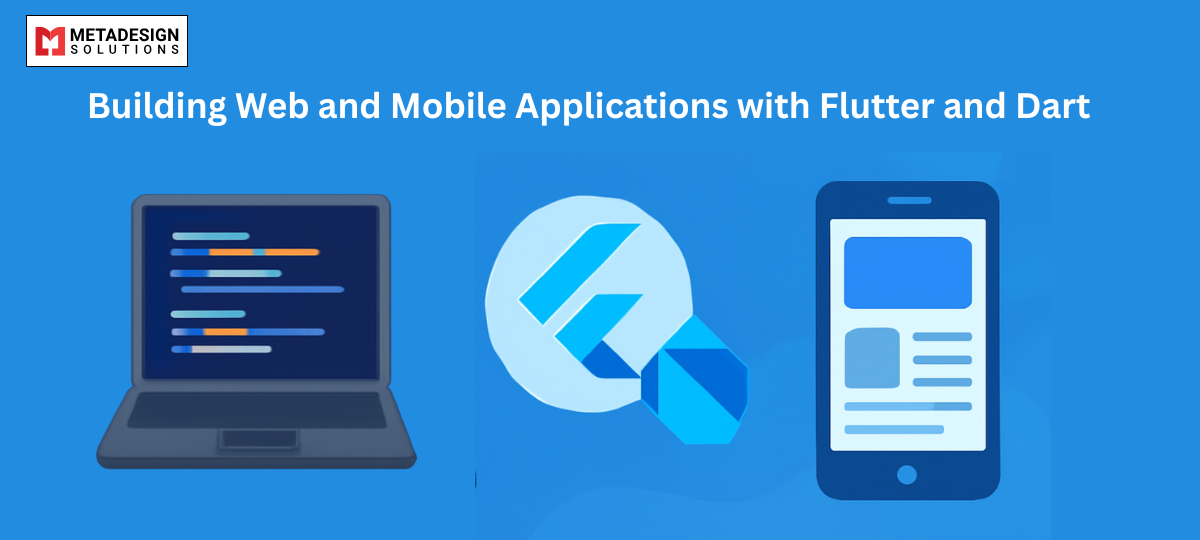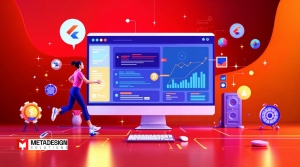Introduction
Are you looking for a powerful framework that allows you to develop both web and mobile applications seamlessly? Look no further than Flutter SDK and the Dart programming language. Flutter has gained immense popularity among developers for its ability to create stunning, high-performance applications with a single codebase. In this blog post, we will explore how Flutter development services and Dart can be used to build web and mobile applications, along with some code samples to illustrate the process.
In today’s fast-paced digital world, businesses and developers are constantly looking for ways to create applications that work across multiple platforms. Traditionally, building applications for different platforms, such as iOS and Android, required separate development efforts using different programming languages and frameworks. However, with Flutter SDK, developers can now build high-quality applications for both mobile and web platforms using a single codebase. If you’re looking to leverage the power of Flutter, you can hire Flutter developers to ensure the success of your cross-platform development projects.
Overview of Flutter SDK and Dart Programming Language
Before we dive into the details of building web and mobile applications with Flutter and Dart, let’s have a brief overview of these technologies. Flutter is an open-source UI software development kit developed by Google. It allows developers to build native interfaces for iOS, Android, web, and desktop from a single codebase. Flutter’s key feature is its “hot reload” capability, which enables developers to see the changes they make to the code immediately reflected in the running application.
Dart, on the other hand, is a programming language developed by Google. It is the primary language used for developing applications with Flutter. Dart combines the best features of object-oriented programming (OOP) and just-in-time (JIT) compilation, making it an efficient and developer-friendly language.
Building Mobile Applications with Flutter
1. Setting up the Development Environment
To start building mobile applications with Flutter, you need to set up your development environment. First, you’ll need to install Flutter SDK and Dart on your machine. Detailed installation instructions can be found on the official Flutter website.
2. Creating a New Flutter Project
Once your development environment is set up, you can create a new Flutter project using the Flutter CLI (Command Line Interface). Open your terminal or command prompt, navigate to the desired directory, and run the following command:
flutter create my_app
This command will create a new Flutter project named “my_app” in the current directory.
3. Designing the User Interface
One of the key strengths of Flutter is its rich set of pre-built UI components, called widgets. Flutter provides a wide range of widgets that can be combined to create beautiful and interactive user interfaces. You can customize these widgets to match your application’s design requirements. Flutter follows a reactive programming model, where the UI is updated automatically whenever the underlying data changes.
To design the user interface of your Flutter mobile application, you can leverage Flutter’s widget tree structure. The widget tree represents the hierarchy of UI elements, with each widget being a building block of the UI. You can nest widgets within each other to create complex UI layouts.
4. Implementing Functionality
Once you have designed the user interface, it’s time to implement the functionality of your mobile application. Flutter uses Dart as its primary programming language, which offers a wide range of features and libraries to facilitate application development.
You can define event handlers and callbacks to handle user interactions, such as button clicks or form submissions. Dart’s syntax is concise and easy to read, making it a developer-friendly language. You can write business logic, perform data operations, and interact with external APIs using Dart’s extensive library ecosystem.
With Flutter’s “hot reload” feature, you can make changes to your code and see the results instantly without restarting the application. This iterative development process significantly speeds up the development cycle and allows for quick experimentation and debugging.
Building Web Applications with Flutter
Flutter’s versatility extends beyond mobile platforms. With the introduction of Flutter for web, developers can now build web applications using the same codebase they use for mobile applications. This eliminates the need for separate web development efforts, resulting in faster development cycles and code reuse.
1. Enabling Flutter for Web
Before you can start building web applications with Flutter, you need to enable the Flutter web support in your project. This can be done by running the following command in your project directory:
Build Stunning Apps with Flutter & Dart
Ready to develop powerful web and mobile apps? Book a consultation today to see how our Flutter and Dart experts can bring your project to life.
flutter config --enable-web
2. Creating a New Flutter Web Project
Once you have enabled Flutter for web, you can create a new Flutter web project using the Flutter CLI:
flutter create my_web_app
This command will generate the necessary files and configurations for a Flutter web project.
3. Designing the Web User Interface
Similar to mobile applications, Flutter provides a wide range of widgets specifically designed for web applications. These widgets allow you to create responsive and dynamic web user interfaces. You can leverage Flutter’s layout widgets, such as Rows, Columns, and Flex, to create flexible and adaptive layouts that adjust to different screen sizes.
4. Implementing Web-Specific Functionality
When building web applications with Flutter, you may need to implement web-specific functionality or interact with browser APIs. Flutter provides plugins and packages that allow you to access browser features and services. For example, you can use plugins for handling browser storage, making HTTP requests, and integrating with JavaScript libraries.
Flutter’s web support is still evolving, and while it provides excellent cross-platform capabilities, there may be certain limitations or differences compared to traditional web development frameworks. It’s essential to stay updated with Flutter’s documentation and community to leverage the latest features and best practices for web development.
Code Samples and Examples
To help you better understand how to use Flutter SDK and Dart programming language for building both web and mobile applications, let’s take a look at some code samples and examples.
1. Mobile Application Example
Here’s an example of a Flutter mobile application that displays a simple counter and increments it on button press:
import 'package:flutter/material.dart';
void main() {
runApp(MyApp());
}
class MyApp extends StatelessWidget {
@override
Widget build(BuildContext context) {
return MaterialApp(
title: 'Counter App',
theme: ThemeData(
primarySwatch: Colors.blue,
),
home: CounterPage(),
);
}
}
class CounterPage extends StatefulWidget {
@override
_CounterPageState createState() => _CounterPageState();
}
class _CounterPageState extends State {
int _counter = 0;
void _incrementCounter() {
setState(() {
_counter++;
});
}
@override
Widget build(BuildContext context) {
return Scaffold(
appBar: AppBar(
title: Text('Counter App'),
),
body: Center(
child: Column(
mainAxisAlignment: MainAxisAlignment.center,
children: [
Text(
'Counter Value:',
style: TextStyle(fontSize: 20),
),
Text(
'$_counter',
style: TextStyle(fontSize: 40, fontWeight: FontWeight.bold),
),
],
),
),
floatingActionButton: FloatingActionButton(
onPressed: _incrementCounter,
tooltip: 'Increment',
child: Icon(Icons.add),
),
);
}
}
This example demonstrates the basic structure of a Flutter mobile app development. It creates a simple counter app with a button that increments the counter value on each press. The MyApp class represents the root of the application, which sets the title and theme. The CounterPage widget is a stateful widget that maintains the state of the counter value. The build method defines the UI layout, displaying the counter value in the center of the screen with a button to increment it.
2. Web Application Example
Now, let’s take a look at an example of a Flutter web application that displays a list of items fetched from an API:
import 'package:flutter/material.dart';
import 'package:http/http.dart' as http;
import 'dart:convert';
void main() {
runApp(MyApp());
}
class MyApp extends StatelessWidget {
@override
Widget build(BuildContext context) {
return MaterialApp(
title: 'Items App',
theme: ThemeData(
primarySwatch: Colors.blue,
),
home: ItemsPage(),
);
}
}
class ItemsPage extends StatefulWidget {
@override
_ItemsPageState createState() => _ItemsPageState();
}
class _ItemsPageState extends State {
List _items = [];
@override
void initState() {
super.initState();
fetchItems();
}
void fetchItems() async {
final response = await http.get(Uri.parse('https://api.example.com/items'));
if (response.statusCode == 200) {
setState(() {
final data = json.decode(response.body);
_items = List.from(data['items']);
});
}
}
@override
Widget build(BuildContext context) {
return Scaffold(
appBar: AppBar(
title: Text('Items App'),
),
body: ListView.builder(
itemCount: _items.length,
itemBuilder: (context, index) {
return ListTile(
title: Text(_items[index]),
);
},
),
);
}
}
In this example, we create a Flutter web application that fetches a list of items from an API endpoint and displays them using a ListView.builder. The MyApp and ItemsPage classes are similar to the mobile application example, with some modifications to handle web-specific functionality.
import 'package:flutter/material.dart';
import 'package:http/http.dart' as http;
import 'dart:convert';
void main() {
runApp(MyApp());
}
class MyApp extends StatelessWidget {
@override
Widget build(BuildContext context) {
return MaterialApp(
title: 'Items App',
theme: ThemeData(
primarySwatch: Colors.blue,
),
home: ItemsPage(),
);
}
}
class ItemsPage extends StatefulWidget {
@override
_ItemsPageState createState() => _ItemsPageState();
}
class _ItemsPageState extends State {
List _items = [];
@override
void initState() {
super.initState();
fetchItems();
}
void fetchItems() async {
final response = await http.get(Uri.parse('https://api.example.com/items'));
if (response.statusCode == 200) {
setState(() {
final data = json.decode(response.body);
_items = List.from(data['items']);
});
}
}
@override
Widget build(BuildContext context) {
return Scaffold(
appBar: AppBar(
title: Text('Items App'),
),
body: ListView.builder(
itemCount: _items.length,
itemBuilder: (context, index) {
return ListTile(
title: Text(_items[index]),
);
},
),
);
}
}
In this example, we create a Flutter web application that fetches a list of items from an API endpoint and displays them using a ListView.builder. The MyApp and ItemsPage classes are similar to the mobile application example, with some modifications to handle web-specific functionality.
The fetchItems method makes an HTTP GET request to retrieve the items from the API endpoint. Upon receiving a successful response, the data is parsed using the json.decode function, and the items are stored in the _items list. The ListView.builder widget then dynamically generates ListTile widgets for each item in the _items list, displaying them in a scrollable list.
Advantages of Using Flutter and Dart
Now that we have explored how Flutter SDK and Dart programming language can be used to build both web and mobile applications, let’s discuss some of the advantages of using Flutter and Dart for cross-platform development.
1. Code Reusability
One of the significant benefits of Flutter is its code reusability. With a single codebase, you can develop applications that run on multiple platforms, including iOS, Android, web, and desktop. This saves development time and effort, as you don’t need to write separate codebases for each platform.
2. Hot Reload Feature
Flutter’s hot reload feature is a game-changer for developers. It allows you to see the changes you make to the code reflected in the running application almost instantly. This rapid feedback loop enhances productivity, as you can experiment, iterate, and fix issues in real-time without the need for a full application restart.
3. Rich UI and Native Performance
Flutter provides a rich set of pre-built UI widgets and extensive customization options. You can create stunning and responsive user interfaces that closely resemble the native look and feel of each platform. Flutter’s rendering engine ensures high-performance and smooth animations, delivering a native-like experience to users.
Conclusion
In this blog post, we explored how Flutter SDK and Dart programming language can be utilized to build both web and mobile applications. We discussed the process of setting up the development environment, designing user interfaces, implementing functionality, and provided code samples for reference.
In conclusion, Flutter SDK and Dart programming language offer a powerful combination for building both web and mobile app development. The ability to write code once and deploy it on multiple platforms, along with the excellent performance and rich UI capabilities, make Flutter a popular choice among developers. Whether you are a beginner or an experienced developer, Flutter provides the tools and resources to create stunning and feature-rich applications.
Related Keyphrase:
#Flutter #Dart #MobileAppDevelopment #WebAppDevelopment #CrossPlatformDevelopment #FlutterAppDevelopment #MobileApps #DartProgramming #FlutterWeb #AppDevelopmentCompany #FlutterDevelopmentServices #WebDevelopment #TechSolutions #MobileAppSolutions #FlutterServices #HireFlutterDevelopers #HireDartDevelopers #AppDevelopmentServices #MobileAppDevelopmentCompany #FlutterExperts #FlutterCommunity #CrossPlatformApps #CustomAppDevelopment #FlutterApp #DartLanguage #TechConsulting #SoftwareDevelopmentServices #AppDevelopmentCompany #MobileUX #FlutterUI #TechInnovation #FlutterForWeb #WebAppSolutions #HireAppDevelopers #DartDevelopment #FlutterDevelopmentCompany #AppDesign #FlutterProgramming #TechTrends #WebAndMobileDevelopment



